Top Traditional Card Games For Just Two Players
One of the best uses for playing cards is … for playing card games. This primary usage explains why playing cards spread rapidly throughout Europe after they first arrived there in the late 14th century. Add gambling to the mix, and you get a winning catalyst. Over the centuries that have elapsed since then, we’ve learned a lot of secondary uses for playing cards, like card magic and cardistry. But card games continue to be as popular as ever. Casual poker tournaments are found around the world, and the game is even played professionally, receiving television coverage. While classic card games like Bridge may be waning in popularity, at least as far as the everyday person is concerned, over the last century many wonderful new card games have emerged and added to the diverse options for playing a game with a traditional deck of cards. The choices are many: classic trick-taking games like Pinochle or Whist, modern trick-taking games like Hearts or Spades, partnership games like Canasta or 500, social games like President or Palace, and children’s games like Slap Jack or Go Fish.
But what about if you only have two players? In reality, most of us find ourselves with exactly two players, especially if you are looking to play a game with your significant other, or with a friend. Suddenly the options become more limited. A lot of card games can be played with two players, like Canasta. But in many instances the game experience is inferior to the same game played with more people at the table. Fortunately there are a lot of fantastic card games that are terrific with exactly two players.
Here is a carefully curated list of popular two-player games played with standard playing cards. I have focused on traditional games that have already proven themselves, and focused especially on games that are most loved and well-known. Although there are some contemporary two-player card games that are very good, these still need to stand the test of time. I’ve consulted a lot of sources in making this list, and have also drawn on my own extensive experience in playing card games. But it is a subjective choice, so I’ve included a longer list of “Honorable Mentions” at the end, as well as a “What next” section following each game, to point to other strong contenders that are worth looking at. To keep things simple, games are listed in alphabetical order. So find yourself a friend or companion, grab a deck of cards, and see what fun can be had playing one of these fantastic two-player card games!
Cribbage
Cribbage is instantly recognizable due to the iconic board used for scoring. It’s a classic card game that goes back to the 1600s, and despite some quirky rules, is easily my most played two player game of all time. How it works: You each get a starting hand of six cards, from which you both select two cards that are put face-down into a “crib” that will be revealed at the end of the hand. You play cards in turn, keeping a running total of what their combined value is, until you can’t play more cards without going over 31, at which point the cumulative count starts over. During this process, you score points for things like bringing the count to 15 or 31, as well as combinations of cards like pairs and triples of the same value, or runs with three or more cards of consecutive values. After you’ve both played your hand, a random “cut card” is added to your hand and you each score points for similar combinations, and one player also earns the points in the “crib”. The goal is to be the first player to score 121. [Video: How to play] What’s good about it: Cribbage, let me count the ways that I love thee. In fact, in another article I suggested twenty reasons why Cribbage is a great game. It is a little quirky, and you’ll probably need the help of an app or some “how to play” videos to learn the rules. But it has the perfect mix of decision making and luck, which ensures it is rewarding and yet casual. Much of the tactics and strategy revolves around what two cards to choose for the crib, and how to play the four cards in your hand, taking advantage of probability and anticipating likely plays from your opponent based on what he’s played. The asymmetry of game turns, the race-like feel and multiple mini-battles, the perfect mix of luck and skill, the myriad of point-scoring combinations – there’s so much to love about this game once you’ve got over the initial barrier of learning it. What next: There’s nothing that is really remotely like Cribbage, but you might try two solitaire versions that are both good: Cribbage Squares, and Cribbage Solitaire. If it’s forming scoring combinations in sets and sequences that you enjoy, then take a look at David Parlett’s Abstrac, which is one of his most popular original games.
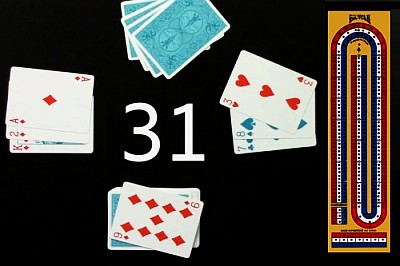
German Whist
German Whist is the first example of a trick-taking game on this list, a popular genre where game-play revolves around everyone playing a card, and the “trick” going to the person who played the highest valued card. Also called Honeymoon Whist due to its suitability for two players, German Whist is in the tradition of the classic Whist. How it works: The initial face-up card of the stock determines the trump suit for the hand. You each get a hand of 13 cards, and in turns play a card to decide who wins the top card of the stock, which is always kept face-up, while the loser of a trick gets the face-down card underneath it. In that way both players each get a replacement card each trick, with the winner leading the next trick. Once the stock is depleted, you play out your hand of 13 cards, and the person who gets the most tricks from these 13 tricks wins the game. [Video: How to play] What’s good about it: Most trick-taking games require at least three or more people to work well, but German Whist is a rare exception that works perfectly with just two players. Games play very quickly, and hand management is very important as you try to set up a strong hand for the final 13 tricks that will determine the winner. You’re constantly working with partial information, because although you know the top card you are both playing for, the face-down card below it that goes to the loser could be an unknown power card or a dud. So there’s a definite element of luck, and yet there’s significant decisions to make that allow real room for skill, especially if you try to remember what cards have been played and which ones remain in the game. What next: David Parlett’s Duck Soup is a very fun variation of German Whist that adds some thematic flavour and novel twists, which make it stand up well as a good game in its own right. Other solid trick-taking games for two players are suggested below under Le Truc (a bluffing game) and under Schnapsen (a more calculating game). Honeymoon Bridge and Bridgette are other options, but these are both two-handed Bridge variants that require considerable investment into the game, just like their ancestor Bridge itself. For three or more players, Knock-out Whist is an excellent casual choice that scratches a similar itch to German Whist.
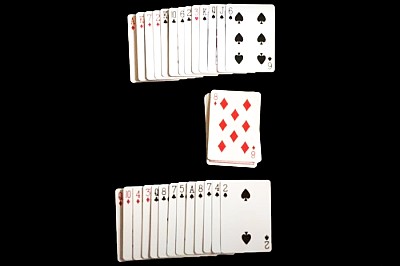
Gin Rummy
Gin Rummy is the king of the large number of Rummy games, at least when playing with just two players. The core concept of Rummy involves you drawing and discarding cards, while you try to create “melds” that consist of cards of matching values (a “set”) or of consecutive values (a “run”). Gin Rummy originated in the first half of the twentieth century under the name Poker Gin or Gin Poker, and became a craze after it was popularized by celebrities in Broadway and Hollywood. How it works: Players each receive a hand of ten cards, and the object is to collect sets and runs. On your turn you take the top face-up card from the discard pile, or the top face-down card from the draw pile. Unlike most other forms of Rummy, in Gin Rummy you keep melds in your hand until the end of a hand, which is triggered by a player “knocking”. You earn points for the completed sets and runs in your hand, with cards worth their value and court cards worth 10. The aim is to achieve a certain score over multiple rounds. There are many minor variations to the gameplay, such as adjustments to the number of starting cards. [Video: How to play] What’s good about it: This is a terrific two player game that has stood the test of time well, and many people would consider it to be one of the top games on this list. The fact that it could be paused and continued at any point made it perfect for actors killing time while waiting for their cue to come on stage, which accounts for some of its popularity. There’s constant tension because you don’t really know how close your opponent is to laying down his hand. Meanwhile you’re waiting for the right cards to come around, which can produce jubilation or frustration, depending on what you draw. The game is very easy to learn and play, and still holds up well today. What next: Basic Rummy is also popular. There are some excellent thematic Rummy games published commercially that are fun for two players, such as the Mystery Rummy series by Mike Fitzgerald. The Rummy inspired Canasta became a real hit in the 1950s, and while it’s best as a partnership game for four players, there are two player variations that some people enjoy a lot.
Golf
Golf is one of the more casual and lighter games on this list. Its name reflects the fact that it is often played as nine “holes”, with the aim of getting the lowest cumulative score. How it works: Each of you is dealt six random cards that you play face-down into a grid consisting of two rows of three cards. You each turn two cards face-up to begin, and the aim is to have the lowest total value of cards visible by the time all cards are face-up. Matching cards of the same value in a column cancel each out, while Kings count as zero, and 2s as minus points (a good thing!). On your turn you take the top card of the face-up draw pile (or the top card of the face-up discard pile), and either discard it or use it to replace one of the cards in your grid, thus sending that card to the top of the discard pile. Lots of gameplay variants exist, but start by looking up six-card Golf. [Video: How to play] What’s good about it: As the game progresses, you’re trying to minimize the face-up points in your 3×2 grid, but discarding a card always has the risk that it could help your opponent. So at times you have to take your chances, hoping that getting a matching card will cancel out some high valued cards in your grid. But there’s always an element of press-your-luck, because the end of each hand is triggered when one player has all six of their cards face up, which effectively functions as a timer that you can use in your favour or that works against you. You also have to be careful that whatever you discard doesn’t help out your opponent, and sometimes you’ll play a card only to realize that what you gave up was even better. It’s a very light game full of moments of both angst and frustration, as well as lucky draws and triumph.
GOPS
GOPS owes its name to an acronym, which stands for “Game Of Pure Strategy”, since it is billed as being a game without any luck. It uses just three suits from a standard deck. How it works: You remove all 13 Diamond cards, which are shuffled and revealed one at a time, and are up for bid. Each of you gets another suit (e.g. Clubs or Spades) which functions as your hand, and which you’ll select a card from to bid for whichever Diamond is currently up for auction. You simultaneously reveal your chosen card, and whoever played the highest gets the Diamond currently on offer. A tie is resolved by revealing the next Diamond and playing another card from your hand to win both it and the previous one. Diamonds won count as points corresponding to their value (Aces count as 1, Jacks count as 11, Queens as 12, and Kings as 13), and the aim is to get the highest cumulative score from the Diamonds you win. [Video: How to play] What’s good about it: GOPS arguably distils trick-taking to its basic essence, although it could equally be considered a game of bidding and bluffing. The fun lies in trying to outguess your opponent, e.g. if you think that he’s going to concede a trick by playing a low valued card, perhaps you can save your better cards for later in the hand by trying to win the Diamond currently up for auction with a relatively low valued card. And the further into the game you get, the more information you have to work with, both about how your opponent plays, and more importantly about the cards remaining. The entire game is all said and done after playing just 13 cards, so it’s over before you realize it. Let’s play again! What next: Definitely try taking your bluffing to the next level by trying Le Truc, which is the next entry on this list.
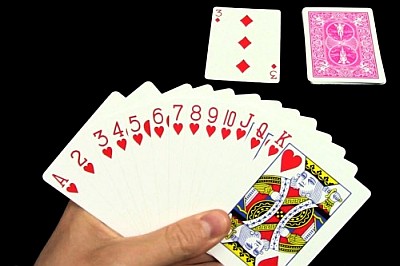
Le Truc
Le Truc is descended from the much simpler English bluffing game Put. While it is related to the Spanish Truc (best enjoyed with four players as a partnership game), Le Truc is the French form of the game that goes back to the 19th century. Sid Sackson helped popularize it by including it in his book Gamut of Games. Remove 2s through 6s from a full deck to play, because it uses a 32 card deck with a somewhat unorthodox ranking of values. How it works: Suits don’t matter at all in this simple trick-taking game. You each get three cards that you’ll use for only three tricks, each of which goes to the highest card played, and tied tricks going to whoever wins the next trick. Winning the hand requires winning two out of three tricks, and earns a point, and the goal is to be the first player to 12 points. But the genius is that before playing a card you can propose to increase the amount of points that the current hand is worth; your opponent can fold and concede rather than increase the stakes. To prevent too much luck, the person leading can also propose a redeal before the first card played. What’s good about it: Le Truc has to be one of the ultimate bluffing games, because it’s amazing how much bluffing it packs into the play of just three cards. In fact, it’s all about the bluffing, because it can happen that a player concedes with hardly any cards played. Even the proposal to redeal can be a bluff to disguise a strong hand. Much of the game-play happens in the mind, because when folding, neither player reveals their unplayed cards. If you like bluffing, this is sheer brilliance! What next: Put has a similar feel to Le Truc, but is much simpler. For a next step, you really should head next to Watten, a classic trick-taking game usually played with four players in partnerships, but also spoken of highly when played with just two players. Some describe it as having much in common with Le Truc, but with some additional complications and aspects to think about.
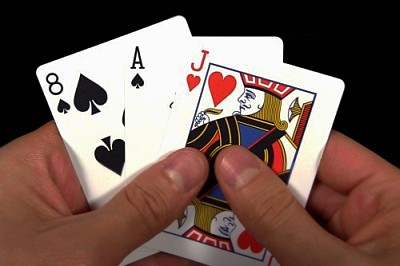
Schnapsen
Schnapsen is the national card game of Austria, and continues to be a popular game in Europe and around the world. This is one of the more challenging games on this list, both in terms of rules and gameplay, but it’s well worth the effort to learn. Like Le Truc, it’s a trick taking game that has a long history, and uses a stripped deck, in this case only 20 cards. Sixty Six is basically a variant with only some minor differences, the main one being that it uses a 24 card deck, with a player hand size of six instead of five cards. How it works: You deal out half the deck to the players, each getting a hand of five (Schnapsen) or six cards (Sixty Six). The other half of the deck becomes the stock, and one card is turned up to determine the trump suit. In the initial phase of the game you don’t need to follow suit, but once a player decides to close the stock, you must follow suit from then on. The basic idea is to capture point-scoring cards in tricks. A special feature of the game-play is how points are scored for King-Queen pairs, called “marriages”. The goal is to be the first player to 66 points, hence the name of the game. [Video: How to play] What’s good about it: This is the third trick-taking game on this list. Le Truc is the lightest of the bunch and full of bluffing, German Whist strikes a good balance between luck and skill, and Schnapsen is by far the most serious of the lot. As far as two-player tricking games go, it is arguably the very best there is, in terms of how much depth and variety it affords with so few cards. There are some rule variations, and it can be a bit knacky to play well, given how important each decision is. Card counting is critical, and there’s scope for real skill. Deciding when to close the stock involves a real risk and adds significant tension to the game. What next: Other more serious trick-taking games that are good with two players, in order from more accessible to more challenging and skilful, are: Briscola (perhaps better with more players, but still well worthwhile with just two), Ecarte (a good two-player alternative for fans of Euchre), Bezique (a Pinochle style game), Klabberjass (also called Clob), and Piquet (has some complications, but is quite deep).
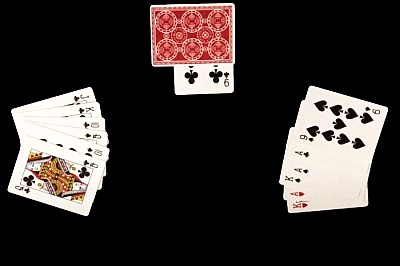
Scopa
Scopa is a classic Italian card game that shines with just two players, although its four player partnership version (Scopone) is also excellent. Variations are popular in countries like Argentina and Brazil. Scopa is considered a “fishing” game, which represents a mechanism where you match a card in your hand with one or more face-up cards on the table. Cassino is like Scopa but increases complexity and tactics. How it works: You use a 40-card deck stripped of the courts, with cards Ace through 10 each worth their numbered value. Four cards begin face up in a central pool, and both of you start with a three card hand, which is replenished from the stock after you’ve both exhausted your hands. You use the cards in hand to “capture” cards from the pool, either by capturing a card of that matches the value as the one you play, or by cards that add up to its value. At the end of a hand, you earn a point for four categories: most cards, most diamonds, most 7s (the actual rule here is a bit more complex), and 7 of diamonds. You get bonus points during play if you “sweep” (= scopa) cards on the table to clear the pool. The first player to score 13 points over several hands is the winner. [Video: How to play] What’s good about it: This is an enormously satisfying to play, and relies on a mechanic that most people don’t have experience with, giving it a very different feel from more common trick-taking games. Captures should never be done on auto-pilot, because you need to be careful not to set-up your opponent for a free “scopa”. Achieving a scopa can be a real highlight of the gameplay, and the chance of this happening helps keep games lively and suspenseful. Keeping track of cards played will also help you make better decisions. Scopa still falls into the casual category, but there’s enough going on that makes it rewarding to play as well. Playing it with an Italian 40-card deck adds authenticity, but it works equally well with a stripped down French-suited deck.
Spit!
Spit! is sometimes called by the alternative name Speed, but strictly speaking Speed is a game with different rules. But they are closely related, and the alternative name captures the essence of both games. This is a very high energy game that dispenses with player turns, and sees both players simultaneously playing cards as quickly as they can. It’s especially great for younger players. How it works: You deal the deck evenly into two halves, one for each player. You each get a starting tableau of five piles consisting one to five cards respectively, with the top card of each turned face-up. Your remaining cards form your personal “Spit” pile. On the count of “1, 2, 3, Spit” you both play a card from your Spit pile onto the center of the table, and from this point the game goes into crazy mode, as you simultaneously play cards from your tableau that are one higher or lower on these two cards in real time, ignoring suits. If you both get stuck, you resume gameplay by simultaneously playing a new card from your Spit piles. Once someone’s tableau is exhausted, you both slap the two pile you think is smallest, which is then shuffled with your remaining cards to become your new Spit pile. The entire process is repeated multiple times, and the aim is to be the first to get rid of all your cards. [Video: How to play] What’s good about it: Spit! is easy to learn, making it ideal for children and families, or even as a casual game between friends who enjoy quick gameplay and trash talking. You’ll need lightning reflexes to play well, and that’s exactly a big part of its charm. To prevent things being too chaotic, it’s customary to insist that you may only use one hand when playing. Sometimes you’ll be playing card after card, but there will be moments where you get stuck, and you’re just waiting for your opponent to lay down the card you need so that you can play one of yours. What next: Speed is a very closely related variation, a key difference being that instead of having five rows of piles, you work with a hand of five cards. If you enjoy real time games like this, Nertz is essential, but the frenzy of its fast-paced gameplay is best enjoyed with more players.
Spite and Malice
Spite and Malice can handle up to five players, but is at its best with just two. Like Spit!, it’s well suited to playing with children as well. It descended from the 19th century two-player game Russian Bank (Crapette), which in turn is a more complex derivative of Double Solitaire (also known as Double Klondike). Also called Cat and Mouse, Spite and Malice well known to many people via its commercially produced variation Skip-Bo. How it works: Using two decks, this is effectively a competitive form of classic solitaire (patience). You each get a pile of 20 face-down cards, with the top card always face-up. The goal is to be the first player to work through this pile. On your turn you first draw (or replenish) a hand of five cards, and then play or move cards into one of two areas: shared building piles that build up from Ace through Queen (suits are irrelevant), playing cards from your face-down pile whenever you can; or four personal discard piles. Kings are wild and can represent any valued card. Depending on the desired game length, you can deal ess or more cards to each player at the start of the game. Quite a number of different variations of game-play exist. [Video: How to play] What’s good about it: There’s something addictive and satisfying about the classic Klondike Solitaire, and this does a good job of simplifying it significantly, and turning it into a competitive game. Other attempts to turn Klondike into a multiplayer game, such as this game’s simpler ancestor Double Solitaire (Double Klondike), are not nearly as satisfying. Spite and Malice is easy to learn and play, and there are moments where you can play many cards in succession, making rapid progress through your starting pile. Careful use of Kings and of your discard pile adds some room for strategy, but there’s always the tension of needing to draw the right cards. Yet there’s good interaction, because a card your opponent plays to a shared foundation pile may just be what you need to unleash a series of cards on your way to victory. What next: Spite and Malice has turn-based play, but ramp up the energy level in the competitive patience style game Nertz (also known as “Racing Demon” or “Pounce”, and published commercially as Dutch Blitz or Ligretto), which is a competitive multiplayer solitaire game where all players play simultaneously in real time. It also introduces more skill because your personal discard piles become a tableau where you can arrange cards downward by alternating colours, just like in Klondike Solitaire. While Nertz can be played with just two players, it is admittedly at its best when played with more players. Kings in the Corner is another game that offers somewhat of the feel of classic solitaire in how cards are built.
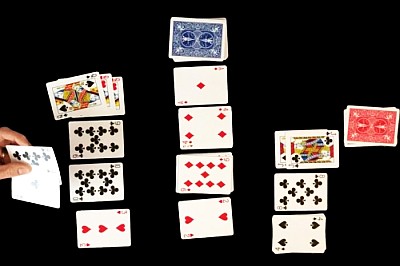
Honorable Mentions
Many other great candidates could have made a list like this, and I’ve already mentioned some under the “What next” sections. Here are some other good two player card games worth trying if you want to explore further. Trick-taking games One of the most popular families of card games, trick-takers are games where each player has a hand of cards, and in turns plays a card following the suit played by the first player, with the winner of the suit winning the trick. Trump suits and point cards can add extra elements of interest to game-play. ● Bezique – A classic trick-taking game for two players from France that was all the rage in the early 20th century, and bearing some resemblance to the two player version of the popular American game Pinochle. ● Briscola – An Italian trick-taking game using a 40 card deck, where you’re playing tricks (without needing to follow suit) from a three card hand to win point-scoring cards. It’s better with more players, but still an excellent game for just two, and is easy to learn and play. ● Ecarte – An excellent two player only game of French origin that has a lot of resemblance to its close cousin, the popular partnership game Euchre. Climbing games Climbing games are a type of shedding game, where the objective usually is to be the first to empty your hand of cards, sometimes earning points for cards captured by playing the highest ranked cards. Multiplayer climbing games like President, Tien Lien, and Big Two are very popular, but some good two-player climbing games also exist. ● Dickory – A lighter two player climbing game of recent origin, that was specifically created to fill a gap in this niche. ● Durak – Usually played with four but also good with two, this popular and fun Russian game has the aim of not being the player left with all the cards. ● Haggis – A climbing game designed just for 2-3 players, and a highly acclaimed game that has proven very popular with serious boardgamers. Rummy and Fishing games Gin Rummy and Scopa are already on the list above, but many great card games are related to these two archetypes, including several that also work well for two players. ● Cassino – A fishing game where you capture face-up cards in a common pool by playing matching cards from your hand, and a more tactical game that is a good step up from Scopa. ● Canasta – Normally best as a partnership game for four players, this Rummy style game from the 1950s has a good two player variation enjoyed by many. ● Rummy – The granddaddy of the many Rummy games, straight Rummy caters for 2-4 players and is a melding game much like its popular descendant Gin Rummy. Instead of waiting till your hand only consists of sets or runs, on your turn you can meld and optionally lay off on opponent’s melds.
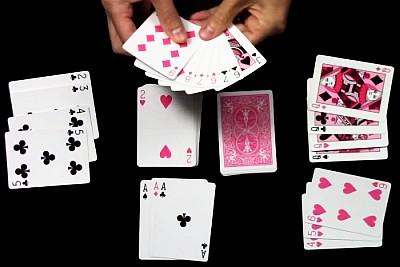
Children’s games Some classic kid’s games like Go Fish and Old Maid aren’t ideal with just two players, but the following all work well as two player games, although some of these tend to be very simple games that will only amuse younger children. ● Crazy Eights – The game that UNO derived from. The objective is to be the first to get rid of all your cards by matching the number or suit of the previously played card, while certain cards have special abilities like Skip or Draw Two. ● James Bond – A more recent children’s game that is growing in popularity, also called Atlantis or Chanhassen. You’re trying to be the first to collect a set of four matching cards by exchanging cards with four face-up cards in the middle. ● Slapjack – Try to be the player with the most cards, by being quickest to slap the pile and get all its cards each time a Jack is played. It’s somewhat similar in feel to Snap, and easier to play than the related game Egyptian Ratscrew, which is best with more players. ● War – An entirely luck-based game but still very popular with kids, where players simultaneously turn up cards, and have a “war” each time they play cards of the same value, with the cards going to the player who then plays a higher card. Combat games These combat games are more contemporary titles that use cards in unorthodox ways, to attack or defend against other players, in a manner reminiscent of the gameplay from popular trading games like Magic the Gathering and Yu-Gi-Oh. ● Cuttle – A surprisingly quick and satisfying game where the goal is to be the first to 21 or more points in cards on your side of the table. ● Dueling Nobles – Somewhat math heavy, this is an innovative game that uses cards, tokens, and dice, and was also inspired by trading games. ● Regicide – A cooperative fantasy themed game designed for a regular deck. It has become a huge underground hit in the boardgame community, and has great potential. Wild cards Games in this category are lesser known titles that are a little more off the beaten path, and yet have proven to be very rewarding to those who have taken the time to learn and play them. ● Kings in the Corner – You’re trying to be the first to get rid of all your cards by playing them in a solitaire-style layout, with eight piles that build outwards with alternating red and black cards in descending order. For a more traditional solitaire fix in a two player game, try Double Solitaire. ● Lamarckian Poker – A fun filler for 2-6 players about evolving the best Poker hand. This blind bidding and drafting game was first issued as part of the excellent Poker Suite from Cheapass Games. ● Sedma – An out-of-the-ordinary trick taking game recommended by David Parlett, and originating from Eastern Europe, where a card can only be beaten by a card of equal value or by a seven. ● Twenty – An interesting adding game where you must either draw a card, or play cards adding to the total of 1, then 2, and so on until 20. If you like arithmetic games of this sort, then David Parlett’s games Give or Take and Dracula are also worth trying.
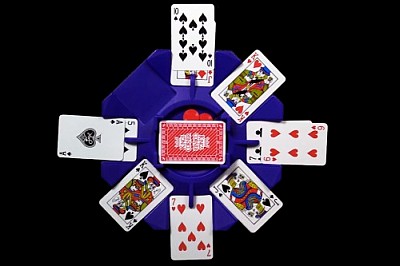
You won’t always be able to find a group willing to play your favourite multiplayer card game, and sometimes it’s just you and a partner. But as you can see, if you’re looking for a two player game with a standard deck of playing cards, there are plenty of fantastic options, including the personalization route. Consider bringing to life your own two-player card game or designing the perfect playing card back with standard faces at shuffledink.com.
So what are you waiting for? Grab your favourite deck of cards, and grab your lover, your brother, your friend, your colleague, your neighbour, or anyone willing to join you, and get playing!
About the writer: EndersGame is a well-known reviewer of board games and playing cards. He loves card games, card magic, and collecting playing cards. This article first appeared on PlayingCardDecks.com here.
About Shuffled Ink
Shuffled Ink is a multigenerational family business that specializes in printing custom playing cards, tarot & flash cards, custom card games, packaging and more for businesses and individuals worldwide.
To receive complimentary samples of our card products, either follow this link or please include your delivery address and phone number on your custom quote request form.